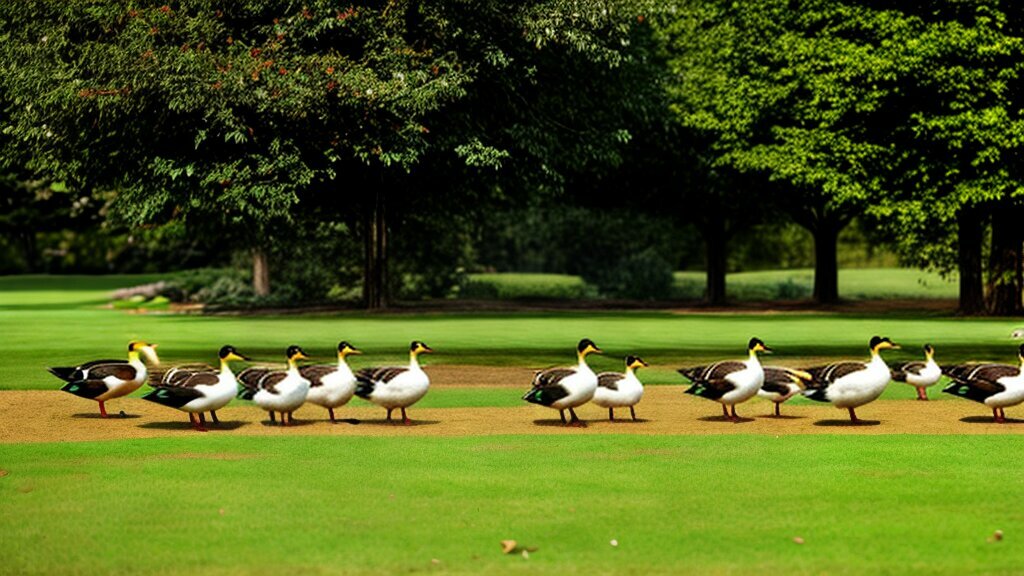Why Do Ducks Stomp Their Feet? Unraveling the Mystery

Table of content:
Ducks are known for their distinctive waddling walks and loud quacking calls. But you may have also noticed ducks rapidly stomping their feet up and down in the water. This strange behavior often occurs in groups, with multiple ducks stomping their feet in unison. So what’s behind this peculiar foot stomping behavior? As it turns out, foot stomping serves several important purposes for ducks.
Foot Stomping in the Water
The most common place to observe ducks stomping their feet is in the water. Mallard ducks and other duck species will often stomp their feet rapidly up and down when floating in lakes, ponds and other bodies of water.
This water stomping behavior helps stir up food from the bottom sediment. By rapidly stomping, ducks are able to disturb algae, plants, insects, crustaceans and other small aquatic organisms that then float up within reach to eat. Essentially, it’s a feeding behavior that helps ducks forage for hidden snacks underwater.
Foot stomping also helps keep ducks stable while floating on the water surface. The up and down motion creates turbulence under their bodies that prevents them from drifting with currents or waves. The splashing can further create ripples that scare small fish toward the ducks to catch.
So the next time you see ducks stomping in unison at the lake, they are likely churning up a feeding frenzy for themselves below the surface!
Communication and Courtship
In addition to foraging, foot stomping serves a social purpose for ducks. Males often use foot stomping displays to attract interest from female ducks. It’s a visual and auditory signal that communicates fitness to potential mates.
The vigorous stomping sends ripples across the surface that catch the eye of other ducks nearby. And the rhythmic stomping creates a percussion that grabs the attention of other ducks, particularly females. This foot tapping behavior is most prominent during mating season as an impressive courtship display.
Mated pairs may also stomp their feet together to reinforce their pair bond. And ducklings may even stomp their feet in unison with their mother as a sign of imprinting. Stomping feet together is a social activity that strengthens connections within duck flocks.
Defense and Aggression
Ducks also use foot stomping as an aggressive display toward territorial competitors or perceived threats. Drakes establish dominance in mating groups through aggressive stomping displays and vocalizations. And ducks may stomp feet in defense of their brood or to establish territory.
The splashing commotion and vocalizations draw attention while also intimidating competing ducks and other animals that may threaten eggs or ducklings. The vigorous stomping shows the duck is strong, energetic and prepared to defend its space if challenged.
So foot stomping allows ducks to communicate vigor and aggression through dynamic visual, audio and physical displays. This behavior establishes boundaries and social hierarchy within duck communities.
Common in Multiple Duck Species
Rapid foot stomping can be observed in multiple duck species beyond just Mallard ducks. Other dabbling ducks like the American Wigeon, Green-winged Teal, Wood Duck and Northern Pintail all share this behavior. Diving ducks such as Lesser Scaup, Ring-necked Ducks and Buffleheads also foot stomp.
In fact, most ducks stomp their feet to some degree. The behavior arises across many duck species because it serves core functions like foraging, courtship displays and communication. Foot stomping provides similar benefits across duck types, habitats and environments.
Short, Quick Stomps
A key characteristic of duck foot stomping is the rapid, up-and-down motion. Rather than slow exaggerated stepping, ducks perform very short, quick and repeated stomps. Their legs essentially vibrate up and down in a fluttering motion that creates turbulence underwater and attention-grabbing sights and sounds above.
This rapid foot stomping allows ducks to maximize the effects that make the behavior advantageous. Quick flutters churn up food and sediment better than slow stomps. And rapid stomping sends stronger visual and audio signals useful for courtship and communication. The speed and repetition are key to the unique duck foot stomp.
Why Ducklings Stomp Their Feet
Young ducklings in their first few weeks of life often stomp their feet vigorously while following their mother. This becomes more pronounced when the mother duck or other ducklings in the brood stomp their feet as well.
Duckling foot stomping serves a few different purposes. One function is imprinting. Stomping together helps the ducklings memorize and mimic the mother duck’s behaviors, strengthening their mother-offspring bond. This imprinting ensures the ducklings recognize and follow their mother.
The splashing activity also provides warmth for developing ducklings in their early stages of growth and feather development. The motion raises their body temperature similar to exercise. Staying warm is critical for their survival and development in the first few weeks after hatching.
So by mimicking their mother’s splashing feet, ducklings are warming their bodies, imprinting and interacting socially within the brood. The group stomping helps form crucial early duckling bonds and behaviors.
Only Present in Some Bird Species
While foot stomping is common across most duck species, it is not a universal waterfowl behavior. For example, swans and geese do not demonstrate rapid foot stomping seen routinely in ducks. The feet and legs of geese and swans are larger and more adapted for walking on land than those of ducks.
Other aquatic birds like coots and moorhens occupy similar wetland habitats as ducks but lack extensive foot stomping behaviors. And shorebirds have different foraging methods that don’t benefit from foot fluttering.
So while various wetland birds share some behaviors with ducks, the pervasive foot stomping seen in duck species appears specially adapted for their ecology and environment over evolutionary timescales.
Conclusion
Duck foot stomping is a fascinating behavior that serves several important functions. By rapidly stomping their feet in the water, ducks can stir up food, stay balanced, communicate and display courtship. This unique duck behavior provides core benefits related to foraging, mating rituals, territoriality, warmth and more.
The next time you observe ducks splashing their feet vigorously up and down, take a moment to appreciate the reasons behind this peculiar phenomenon. It’s a marvel of adaptations that equips ducks with great advantages for survival and reproduction in their aquatic environments. Just another example of the wonders of natural selection and waterfowl behaviors.
Welcome. I’m Adreena Shanum, the proud owner of this website, and I am incredibly passionate about animals, especially poultry. I founded adreenapets.com as a labor of love, stemming from my desire to share my knowledge and experiences with poultry enthusiasts worldwide.




